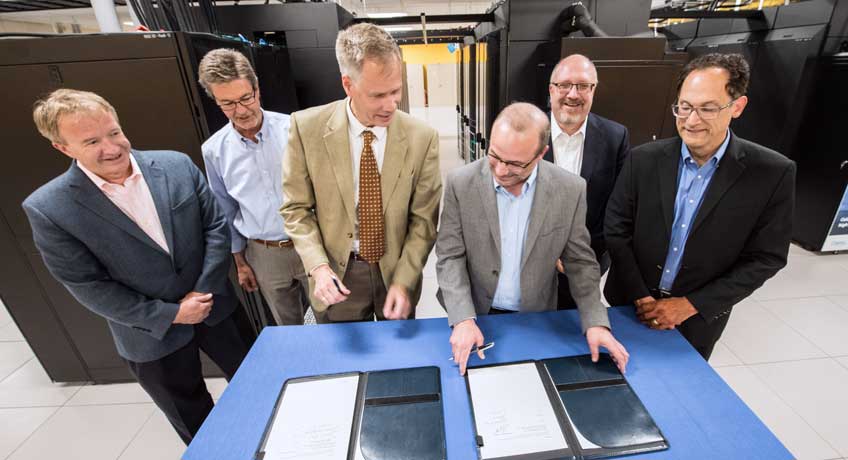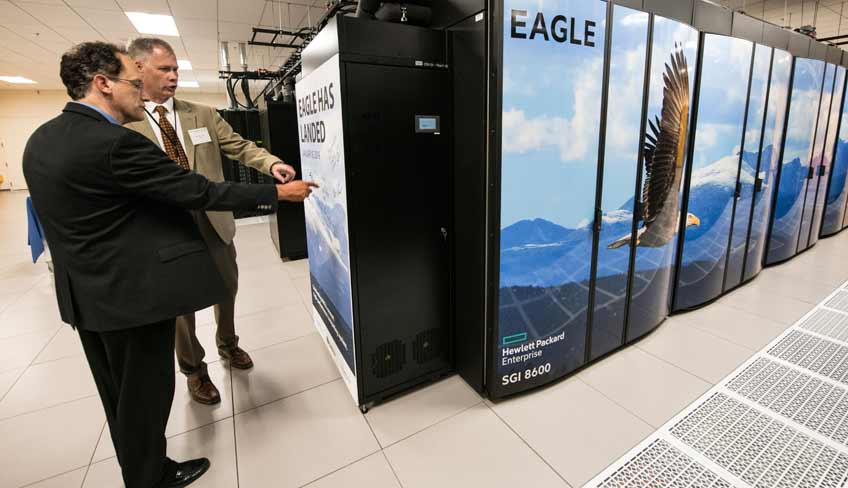Hewlett Packard Enterprise and NREL Expand Partnership with New Focus on Edge and Data-Centric Computing

A few weeks ago, NREL Associate Laboratory Director for Scientific Computing and Energy Analysis Rob Leland and members of his team visited the offices of Hewlett Packard Enterprise (HPE) in Houston, Texas. There to finalize a new partnership agreement between NREL and HPE, Leland viewed a replica of where it all began: the birthplace of Silicon Valley.
Like the evolution from the early days of computing to today’s supercomputing superhighway, the long-standing relationship between NREL and HPE has opened many doors for scientific achievement over the years.
“NREL’s latest supercomputer, Eagle, and its predecessor, Peregrine, are world-class products of this fruitful relationship,” Leland said. “We have exciting developments underway in our data center—the world’s most energy efficient, thanks in no small part to our partnership with HPE.”
And there’s more to come.
Two years ago, HPE’s then-CEO Meg Whitman took center stage at NREL’s inaugural Partner Forum as keynote speaker. In 2019, HPE was once again in the spotlight.
Joined by Bill Mannel, vice president and general manager of HPE, Leland announced a new, cutting-edge HPE-NREL joint effort at this year’s Partner Forum: a memorandum of understanding to collaborate on the application of edge and data-centric computing to solve complex energy system challenges. NREL's scientific computing, energy analysis, and energy systems integration researchers will work with HPE to lead the research, which will span a broad range of topics, including:
- Energy system edge computing
- Data-centric computing
- Fault-tolerant computing
- Optimization and integration of grid-edge controls and architecture
- Cybersecurity
- Energy system security and resilience.

High-Powered Computing, High Expectations
The new partnership aims to demonstrate how a thoughtful combination of sophisticated edge computing with traditional computing can enable enhanced control of advanced energy systems.
Toward this goal, NREL and HPE will explore new market opportunities and platforms for edge and data-centric computing, including grid management, integration of distributed energy resources across multiple platforms, and optimization of onshore and offshore wind and solar farms. The work will also involve the development of digital twins for complex energy systems, such as campuses, airports, military bases, smart cities, and transportation networks. New models, methods, analytics, and platforms for energy system security and cybersecurity—including resilient power systems and self-healing grids—are another anticipated outcome.
If past collaborations are any indication of future success, HPE and NREL can look forward to continued computing advancement in the years ahead.
Learn more about computational science at NREL.
Last Updated May 28, 2025
